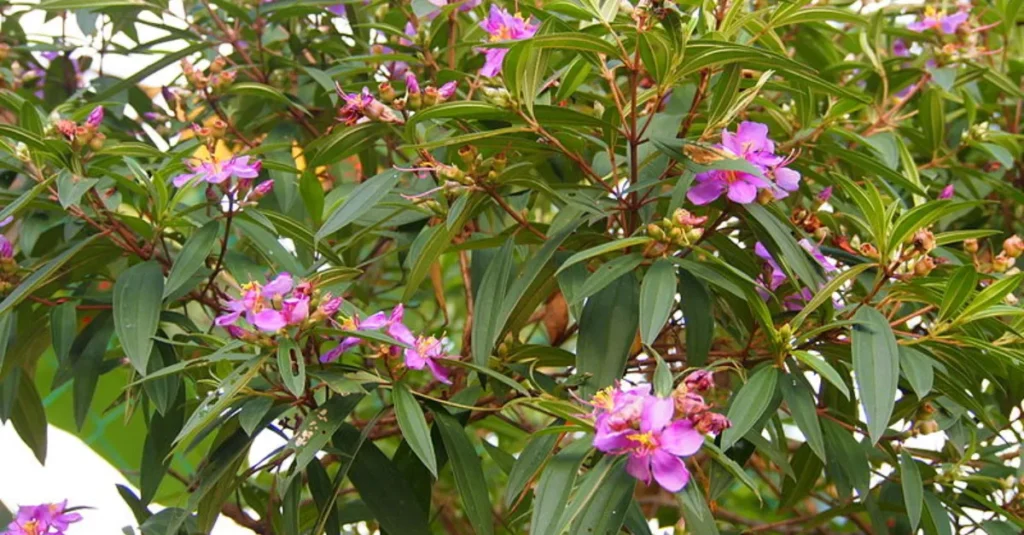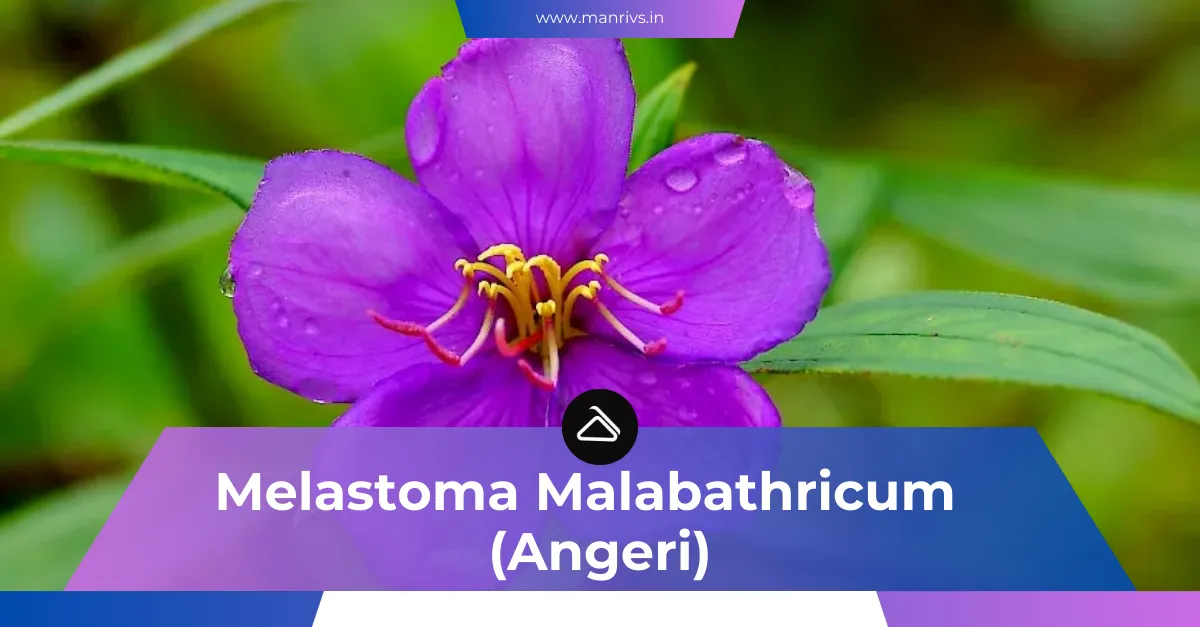Common name of Melastoma Malabathricum: Malabar Melastome, Indian-rhododendron • Assamese: ফুটকলা phutkala, ফুটুকা phutuka • Bengali: ফুটুকী phutuki • Garo: bol khakhu, khakhuchi • Kannada: ಅಂಕರ್ಕೆ Ankarke, ದೊಡ್ಡನೆಕ್ಕರೆ Dodda nekkare, ದೊಡ್ಡನೆಕ್ಕರಿಕೆ Dodda nekkarike, ನೆಕ್ಕರೆ, ನೆಕ್ಕಾರೆ Nekkare, ಕೆಂಕರಿಕೆ Kenkarike • Konkani: नाकेरी nakeri • Lepcha: tungbram • Malayalam: അതിരാണി athirani, കദളി kadali, തോട്ടുകാര tottukara • Manipuri: ꯅꯨꯔꯥꯥꯈꯨꯗꯣꯡꯂꯩ nura khudonglei • Marathi: लाकेरी lakeri, पालोरे palore, रिंधा rindha • Mizo: bui-lu-kham • Nepali: आङ्गेरी angeri, चुलेसी chulesi • Odia: builukham, ଗଙ୍ଗେଇ gongoi, koroti • Rongmei: বোবূচুন্মৈ bobuchunmei • Sanskrit: तिनीशः tinisah • Tamil: கடலை katalai • Telugu: నెక్కరి nekkare, నెక్కరిసెల్య nekkaresaelya, పాతుడు pathudu • Tulu: ನೆಕ್ಕರೆ nekkare
Botanical name: Melastoma malabathricum Family: Melastomataceae (Melastome family)
Source: Names of Plants in India
A Versatile Tropical Shrub
Melastoma malabathricum, also known as Malabar Melastone, or Indian rhododendron, is a beautiful flowering plant belonging to the Melastomataceae family. Native to India, Japan, Southeast Asia and Pacific Islands, it thrives in grasslands and sparse forests at elevations of 100 m to 2,800 m.
Cultivated for its vibrant purple blooms and various local uses such as food, medicine and decoration; this evergreen shrub typically grows between 1-2 m tall but can sometimes reach up to 5 m in height. Commonly found in cleared areas and roadsides under different names depending on location or community usage.
The Melastomataceae family, to which Melastoma belongs, comprises over 4,000 species across tropical and subtropical regions worldwide. The plant features reddish stems covered with small bristly scales that have a four-sided shape. Its pink flowers are arranged in clusters while berry-like capsules hold numerous seeds coated in red sweet-astringent pulp.

Traditional Medicinal Value
Melastoma malabathricum has been used in traditional medicine by various communities and tribes for a long time. The plant’s leaves, shoots, and roots are prepared differently to treat diverse health issues. Known for its astringent properties, it is commonly used to alleviate stomach discomforts, indigestion, diarrhoea, dysentery, and leucorrhoea.
Melastoma malabathricum provides relief when applied externally to cuts, wounds, swellings caused by arthritis or insect stings. It aids in healing sores as well. After childbirth, the roots and leaves can be utilized as gargles for toothaches or topically applied for haemorrhoids.
Despite numerous reports on its medicinal uses in traditional medicine practices, there is currently insufficient clinical data supporting these claims.
Edible Plant with Dye and Cosmetic Uses
The plant’s young shoots can be consumed fresh or cooked, while its ripe fruit offers a sweet taste with a hint of astringency. The small fruit has soft dark blue pulp and orange seeds, measuring 7-11 mm x 6-10 mm. It can also be utilized for creating black or purple dyes to color various materials.
The leaves and roots provide a pink dye suitable for fabrics or other items. The plant’s ashes have potential as mordant – a substance enhancing vibrancy and longevity in fabric colors.
Easy Care but Turns into Troublesome Weeds
This plant thrives in hot, humid tropical areas with low elevation due to its love for heat and moisture. However, some subspecies is found at higher elevations within tropical regions. Melastoma malabathricum plants are low maintenance and easy to care for, growing well in open areas without fertilizers and minimal watering. They are resilient but sensitive to frost, so protection during freezing conditions is crucial.
These plants can become troublesome weeds in pastures, pineapple fields, and other crops grown in peat soils as they spread rapidly. They pose challenges in oil palm, rubber and cotton plantations by competing with desired plants. Managing them can be difficult when they invade fields of cassava, sugarcane, tea and rice.
Remarkable Colonizer and Invasive Weed Combatant
This plant species, known as a finer plant, possesses the remarkable ability to spread and colonize new areas. It can even thrive in fields dominated by the invasive weed, Imperata cylindrica, eventually outcompeting and replacing it. Care must be taken when cultivating this species due to the risk of it escaping and invading non-native regions.
For optimal results, the seeds should be planted fresh – either in a nursery, seedbed or containers – since they are quite small. After successful germination, exposing them to full sunlight or light shade is ideal. In trials conducted on these seeds’ growth rates, 65% were found to germinate within 10-15 days; this figure increased up to 80% after 30 days.

